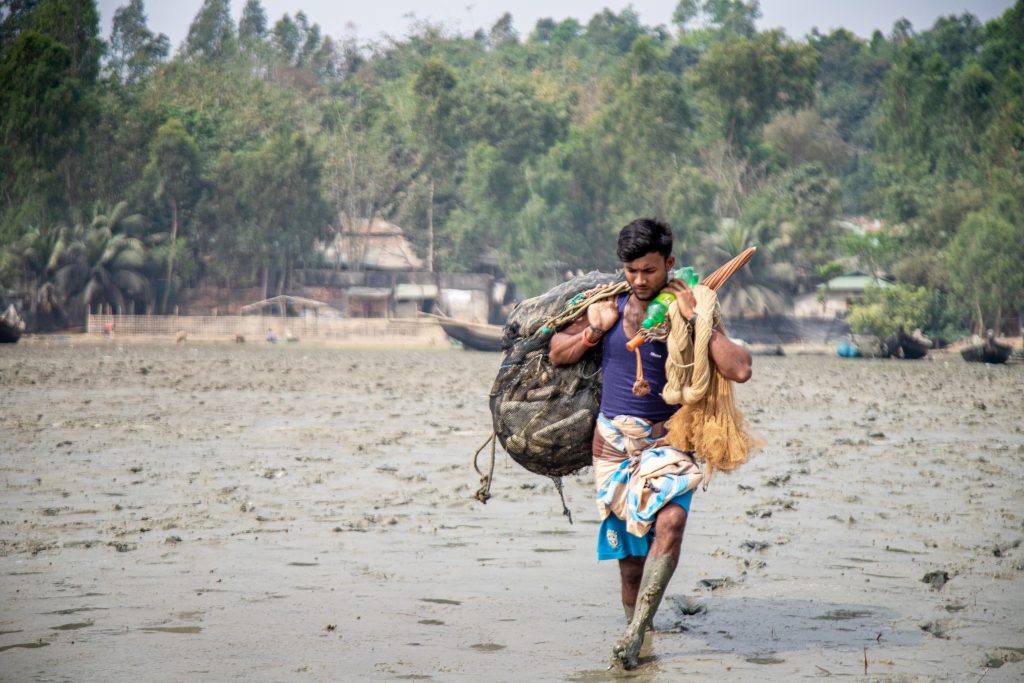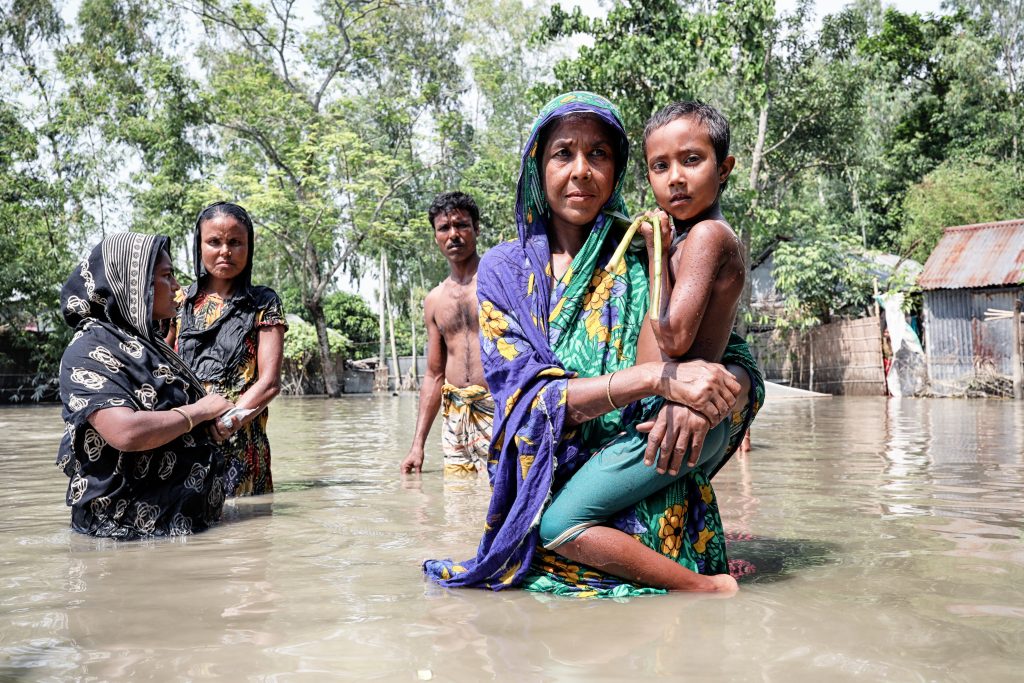Bangladesh/Climate Change
Hotter, Wetter, Saltier
The unique geography of Bangladesh makes it extremely vulnerable to climate change and warrants appropriate tools and strategies to combat and mitigate negative impacts
This article is by Dr. Samiya A. Selim (samiya.selim@ulab.edu.bd), Associate Professor and Director, Centre for Sustainable Development (CSD), University of Liberal Arts, Bangladesh, and Shaikh Giasuddin Ahmed (gias@smanusher.org), Senior Program Manager, ManusherJonno Foundation (MJF), Bangladesh
Bangladesh has been one of the countries most affected by climate change in the last 15 years. It is the seventh most vulnerable country on the Climate Risk Index 2020, according to a recent Germanwatch report.
Bangladesh is geographically unique and is home to one of the world’s largest deltas formed by the Ganges-Brahmaputra-Meghna (GBM) river system. The GBM basin and the coast of the Bay of Bengal is characterized as a semi-enclosed tropical basin. Most of Bangladesh is less than 10 m above sea level. This makes the country extremely vulnerable to climate change, especially around the coastal areas, which are susceptible to cyclones, floods and other extreme weather events. This vulnerability is not only due to bio-physical and geographical factors, but also due to the socioeconomic standing of Bangladesh in terms of its dependency on agriculture and fisheries, and its high population density. Poverty further exacerbates the situation.
… vulnerability is not only due to biophysical and
geographical factors, but also due to the socioeconomic
standing of Bangladesh…
An analysis in 2009 identified Bangladesh as one of top four Asian countries which is climate-vulnerable (besides Cambodia, Pakistan and Yemen), especially due to the importance of fisheries to the nation’s economy and diet, and because Bangladesh has limited capacity to face the potential impacts of climate change. As of 2018, the total fish production of Bangladesh was 4.3 mn tonnes. The sector contributed to 3.57 per cent of the country’s gross domestic product (GDP) and accounts for 60 per cent of the total animal protein intake of the country.
Bangladesh’s vulnerability to the effects of climate change mainly comes from the country’s dependence on agriculture. The rise in sea level is leading to the intrusion of saltwater into the land. This increases soil salinity and creates poor conditions for crop cultivation, apart from decreasing the availability of natural freshwater for consumption and production. Climate-change effects such as floods, riverbank erosion, cyclones and storm surges, continue to cause losses of life, livelihoods and essential infrastructure; if this trend continues, fishers in Bangladesh may have to halt their practices. With sea-level rise and increased salinity of freshwater bodies, aquaculture, fish species distribution and biodiversity in the coastal areas continue to be under threat. Saltwater intrusion has caused many fish farmers to end their usual practices, pushing them to adapt to the changes. Many are now using saline-tolerant species such as tilapia (Oreochromis niloticusand other genetically improved strains) and parsa. The case of hilsa (Tenualosailisha), which accounts for 13-14 per cent of the total fish production of Bangladesh, provides a good insight into the challenges faced by the country’s fisheries.
Threefold increase
Hilsa production from inland waters has declined by about 20 per cent over the last 20 years, whereas the marine catch increased threefold. The major hilsa catch has gradually shifted from inland to marine waters, revealing that the availability of the prized fish is gradually declining in the Padma and Meghna river catchment areas.
For the GBM basin in winter, an expected reduction in the area covered by water bodies may cause favorable fish habitats to dry out, especially in the open-water bodies situated in the basin. This increases the fish death rate, and challenges the survival of open-water fishes due to the loss of their natural habitats. The anticipated rise in rainfall due to climate change will also result in increased river runoff, which is expected to extend the breeding ground for freshwater fish with higher nutrient availability. On the contrary, increased water runoff may cause floods and destroy aquaculture infrastructure. In the table, these climate-change effects and their impacts on aquaculture and fisheries are summarized, based on Bangladesh’s Third National Communication to the United Nations Framework Convention on Climate Change (UNFCCC).
| Effects of climate change |
Impact of climate change on aquaculture and fisheries |
| Flood and river bank erosion
|
|
| Cyclone and storm surge |
|
| Sea level rise |
|
| Salinity intrusion |
|
| Erratic rainfall |
|
| Temperature rise and variation |
|
Recommendations
To address the challenges posed by climate change to coastal and riparian fishing communities in Bangladesh, we have a number of recommendations, based on the key findings of our review of literature. First, more research is needed to accurately anticipate the impacts of climate change on fish populations, and to identify salinity-tolerant species in coastal areas, and freshwater species in inland areas. This knowledge should be disseminated through channels appropriate for coastal fishing and fish-farming communities. Non-governmental organizations (NGOs) and civil society organizations (CSOs) can collect and disseminate a range of information on community mobilization, training, extension and credit disbursement so that the coastal community can adapt according to their needs.

Plans for long-term research on the impacts of climate change on marine and inland fishery resources in the Asia-Pacific region should be made a priority as the lack of continuous and updated data prevents effective policy and action. Geo-spatial mapping and planning should be improved by monitoring the formation of new shoreline areas and new mangrove areas. Additionally, early detection methods for shifts in salinity should be identified and zones delineated to make appropriate adjustments to aquaculture practices.
Finally, the government can mobilize greater financial support and develop suitable projects for the sector. It should create a beneficial environment for climate-friendly investments (through taxing polluting industries and incentivizing ‘green’ production). It should enhance the business environment to attract more foreign investments to implement mitigation and adaptation processes that can benefit coastal areas and communities in Bangladesh.
Conclusion
Regardless of its low contribution to the global greenhouse gas (GHG) emissions, Bangladesh is extremely vulnerable to the adverse impacts of climate change. This vulnerability is amplified as the country’s economy is dependent on the fisheries and aquaculture sector (12 per cent of Bangladesh’s population relies on the sector for their livelihoods), and in terms of foreign exchange earnings from exports. Climate change could cause food insecurity and elevate poverty. If adaptive measures are taken, it could create more opportunities for improved fish-production practices and greater economic development.

In this respect, the government of Bangladesh needs to prioritize the challenges posed by climate change and coastal development. This can be achieved through researching and developing tools and strategies to combat and mitigate negative impacts. A co-ordinated long-term research study should be conducted on the impact of climate change on marine resources in the Asia-Pacific region. Assistance from the international community — both technical and financial — could result in better planning and implementation of sound policy measures. If effective implementation of such policies can be ensured, Bangladesh can be proactive in combating climate change and ensuring the sustainability of its aquatic ecosystems and the development of its fishing communities.
For more
Climate Change and Fisheries: Perspectives from Small-scale Fishing Communities in India on Measures to Protect Life and Livelihood
http://www.icsf.net/images/monographs/pdf/english/issue_121/121_Climate_Change_17May12_3_53PM.pdf
Impacts of climate change on fisheries and aquaculture: Synthesis of currrent knowledge, adaptation and mitigation options
https://www.fao.org/3/I9705EN/i9705en.pdf
A Large Ocean State Seeks Change